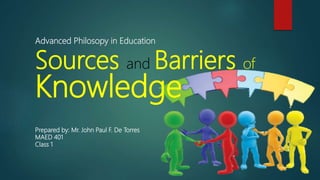
Theory nature source barriers
- 1. Advanced Philosopy in Education Sources and Barriers of Knowledge Prepared by: Mr. John Paul F. De Torres MAED 401 Class 1
- 2. Source of Knowledge Custom – is a group pattern of habitual activity usually transmitted from one generation to another. Traditions – is the handling down of statement, beliefs, legends, and custom from generation to generation especially by words of mouth or by practice.
- 3. Source of Knowledge Intuition – This is a direct perception of fact and truth, which is independent of any reasoning process and considered one possible source of knowledge.
- 4. Source of Knowledge Intuition – According to Carl Jung, a psychologist, this is “thinking which is done on the level of unconsciousness”. On the other hand, Henri Bergson, renowned French Philosopher, referred to intuition as a “dynamic process of thought which penetrated the static limitation of logic”.
- 5. Source of Knowledge For Socrates, “disciplined conversation” is the only way to attain knowledge, which can be called ‘reliable’ in terms of its (knowledge’s) quality.
- 6. Source of Knowledge Sources of Knowledge In Epistemology, a common concern with respect to knowledge is what sources of information are capable of giving knowledge.
- 7. Source of Knowledge Empiricism- refer to experience and observations when beliefs are justified and proven. Rationalism- emphasize reasons, We can gain knowledge independent of sense experience. Logical human mind is source of knowledge.
- 8. Source of Knowledge Reason — it can be considered a source of knowledge, either by deducing truths from existing knowledge, or by learning things a priori, discovering necessary truths Perception — that which can be perceived through the experiences of the senses. The view that experience is the primary source of knowledge is called empiricism.
- 9. Source of Knowledge Introspection — knowledge of one’s self that can be found through internal self-evalution. This is generally considered to be a sort of perception. (For example, I know I am hungry or tired.) Memory — Memory is the storage of knowledge that was learned in the past — whether it be past events or current information.
- 10. Source of Knowledge Testimony — Testimony relies on others to acquire knowledge and communicate it to us. Some deny that testimony can be a source of knowledge, and insist that beliefs gained through testimony must be verified in order to be knowledge.
- 11. Source of Knowledge Authority – Testimonies by individuals who are considered authorities in their specialized fields and verified facts from exceptional and extraordinary fields of various sciences found and attested by qualifies bodies are sources of knowledge.
- 12. Barriers of Knowledge Philosophers have been concerned with finding out if we can really “know” anything in the sense of possessing information that is open to questions. The SOPHISTS, these class of wise men were extremely doubtful about the possibility of discovering anything that was really true.
- 13. Barriers of Knowledge Awareness- refers to widespread communication of Knowledge approaches and activities across the organization. Organizations typically market the available knowledge capabilities and approaches, so people know how to connect to content and expertise.
- 14. Barriers of Knowledge Cultural- encompasses working norms, unwritten or spoken rules about how things work. Corporate culture that does not value knowledge sharing. Range of sub- cultures within the organization that are not bound together by the same value.
- 15. Barriers of Knowledge Distance – separation from individuals, teams, functions and so forth within an organization. Infrequent contact is a form of distance. Experience – refers to the knowledge or competencies that a person develops over time in specific role.
- 16. Barriers of Knowledge Knowledge hoarding –refers to people who are hesitant to share/ contribute knowledge for the good of larger audience. “KNOWLEDGE IS POWER” Relationships –may suffer in organizations that do not provide opportunities to communicate.
- 17. Barriers of Knowledge Time – refers to minute/hours (effort) employees who think they are too busy to share knowledge knowledge outside the scope( misaligned measures) Long learning curves
- 18. Barriers of Knowledge Blind adherence to Authority. This is what referred to as authoritarianism – a belief that knowledge is acquired and validated by way of complete subjection to authority, devoid of effort to find out what is true or false. Propaganda. Often aims at manipulation of ideas to influence the behavior of a large number of people to a certain belief of a particular organization.
- 19. Prejudice. This is an unfavorable opinion or feeling without justifiable grounds or adequate knowledge or information on the issue or subject. An individual with prejudice is emotionally charged. He thinks and reasons resulting from some judgment and action according to his self – interest.
- 20. Linguistic Fallacies. Based on the structure and consistency of an arguments, examples of which are those dealing with play on words.
- 21. Material Fallacies. Errors are based on the content of the argument that is apparently faulty with misleading evidence or an appeal to feeling instead of reason based on logic. Star is heavenly body, but Vilma is a star therefore, Vilma is a heavenly body. Light comes from the sun, but feathers are light, hence, feathers come from the sun.
